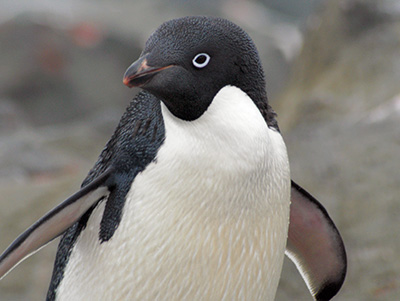 If you only know about the Emperor, Adélie, and Rockhopper penguins thanks to popular movies and what’s often found in your local zoo, you can’t be blamed. But a voyage through the Chilean fjords, the Falkland Islands, and Antarctica will certainly broaden your penguin knowledge. Here’s a little primer before you go.
If you only know about the Emperor, Adélie, and Rockhopper penguins thanks to popular movies and what’s often found in your local zoo, you can’t be blamed. But a voyage through the Chilean fjords, the Falkland Islands, and Antarctica will certainly broaden your penguin knowledge. Here’s a little primer before you go.

Humboldt Penguin (Spheniscus humboldti) also termed Peruvian Penguin, or Patranca, swimming in the clear water.
Magellanic Penguin
Look for these guys around the southern tip of South America or on the Falkland Islands.

Rockhopper penguin Falkland Island, travel to Antarctica
Rockhopper Penguin
Rockhoppers are smaller than other crested penguins, weighing in at around 5.5 lbs (2.5 kg).

Chinstrap Penguin
Like many of their penguin cousins, the Chinstrap feeds predominantly on krill.

Portrait of a Royal Penguin.
Macaroni/Royal Penguin
Macaroni and Royal penguins are often considered distinct species, though DNA suggests Royals may be a variation of Macaronis.

King Penguin (Aptenodytes patagonicus) feeding chick. Falkland Islands.
King Penguin
Dense colonies of these large King penguins can be found up to 3/4 of a mile (1 km) inland on the Falkland Islands.

Emperor Penguin with chick Snow Hill, Antarctica 2010 on the icebreaker Kapitan Khlebnikov
Emperor Penguin
Emperors and Kings may look the same in photos, but the Emperor stands 3.6 feet (1.1 m) tall. The King is only 3 feet (.94 m) tall.

Adélie Penguin
Adélies showed little fear of early explorers’ dog teams, sometimes to their great misfortune.

Gentoo penguins (Pygoscelis papua) on the ice hill
Gentoo Penguin
One of the northernmost penguins, look for the Gentoo around the Falkland Islands.

Humboldt Penguin
Found along the coast of Chile, these may be some of the first penguins you see.
Rare Birds
There are actually 17 different species of penguin recognized as living today. Of those, the African is only seen in southern Africa, the Yellow-eyed, Snares, Little, Fjordland, and Erect-crested are found on or near New Zealand, and the Galapagos is only found on the Galapagos Islands.
To visit the parts of the world to meet with these stunning birds, see Krayton Travel for options


